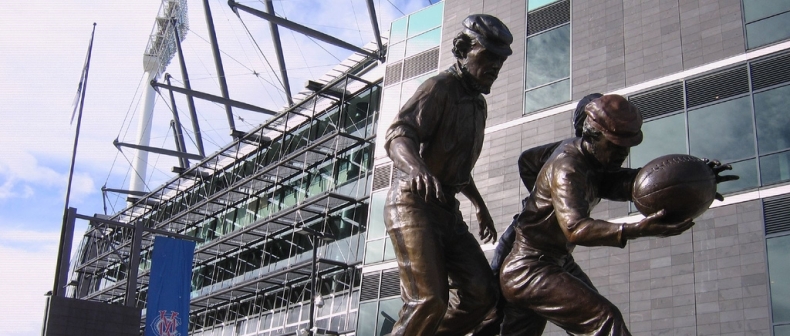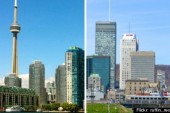
As Commonwealth siblings, Australia and Canada have long been pegged as sister countries. When it comes to infrastructure, employment and cost of living, both countries share some striking similarities. Right now Melbourne and Toronto seem to be keeping pace with each other: both rank high on ‘liveable cities’ surveys and face challenges adapting to rapid growth. In the coming weeks we’ll look at how these two cities compare and what each might learn from the other’s successes.
It’s a bold statement to suggest something is the best in the world at anything. Arrogant even. But here goes: Melbourne is, in my opinion, the sporting capital of the world. There, I said it. What’s more arrogant (and biased) I was born and bred in Melbourne. Before I explain why Melbourne is a sporting city, let’s clarify what it means to be a sporting capital of the world. It means you have more stadiums than you know what to do with. It means those stadiums can hold hundreds of thousands of people all-year round. It means you have a plethora of sporting teams that play in those stadiums and those teams attract the masses. It also means your city has cleverly built the right mix of infrastructure to accommodate all of the above. Melbourne is such a city. Toronto has stadiums, it has teams, but nothing to the scale and impact of what Melbourne dishes up. While Torontonians are glued to their T.V. sets watching their beloved Leafs as they get started and the Raptors who look toward chasing a playoff spot in the second half of their season, Melburnians will cast their eyes to the national cricket team (who take on the West Indies), the pre-season Australian Rules football pre-season tournament (The NAB Cup) and a raft of other sports for the month of February, which is meant to be the quietest month for sport.
Melbourne is full of sports junkies and the city and state governments recognize that. Building a sports city is a win-win for everyone. The population get their sports fix and the city gets to build world-class facilities to show off to the world. With the additions of new stadiums comes the expectation of accessibility and flawless infrastructure — new train lines, streetcar and bus routes, the walkability factor and easily navigated roads. A majority of Melbourne’s world-class stadiums are parked in the city limits and are either at the doorstep of a train station or a five-minute walk from one. Tourists who visit the city are a 10-minute walk to any of the sporting arenas. But it takes more than just plonking down stadiums left, right and centre to become a sporting mecca. You only have to glance at Melburnians eagerness to participate in all kinds of sport — not just the regular world class sports — to see why the city would be considered to be the sporting capital of the world.
This year’s Australian Open crowd, for example, recorded more than 680,000 fans over 14 days. Compare that to last year’s Roger’s Cup that attracted 145,445 in eight days during August. Here’s some more food for thought. A regular season Australian Rules football crowd — not playoffs — at the Melbourne Cricket Ground holds anywhere between 60,000 and 80,000 but can reach up to more than 100,000; the Melbourne Grand Prix set in and around the picturesque Albert Park Lake attracts 114,000 on race day; and the Melbourne Cup, Australia’s premier thoroughbred horse race held at Flemington race track, brings in more than 100,000 punters and fans for the day. Yes, Melburnians actually flock to the race track to watch a horse race as if it were the Superbowl. Comparatively, the largest attendance Woodbine Racetrack has ever witnessed was 42,243.
Cluster of Melbourne stadiums. Image via flickr / Greenstone Girl
When you compare those figures to an average Leafs game at the Air Canada Center (so far this NHL season, the average attendance is 19,300), or Toronto FC match (21, 859) or a Raptors game of 18,036, it pales in comparison. The Rogers Centre’s capacity of 49,539 is more Melbourne’s language and is Toronto’s largest sports stadium; Canada’s fourth largest. But, Melbourne has five “Rogers” stadiums in the city. Some of which have double the capacity. While Toronto boasts three major sporting venues that cater to seven professional teams, Melbourne, a city with four million people, is a city built for all sports. Consider this: It is home to 32 professional franchises and 18 major stadiums (three of those hold more than 100,000 fans). In 1956 it became the first city in the Southern Hemisphere to host an Olympics and in 2010 was named “World’s Ultimate Sports City” for a third time running by Sport Accord and Sport Business.
Some sport pundits allege the catalyst for Melbourne’s hunger for sport stemmed from the 1956 Olympics, but on the contrary, I believe sport was embedded in the Australian culture from the early arrival of convicts that made the journey over from Britain. When Melbourne was founded in 1835, It didn’t take long for sport to evolve into a regimented and highly regulated format. Four years after laying a foundation of the city, the first game of cricket was played between the military and some locals. In 1841, evidence has shown football was being played around the city suburbs. Today both are iconic Australian sports. It’s not just world-class sport that Melburnians crave either. As a country, Australians are notorious for inventing quirky sports to participate in or observe. Some years ago while on vacation at Port Douglas, situated on the north-east coast of Australia, I came across a tin shed that called itself a pub. Inside the dingy establishment a series of cane toad races were in progress. For those who have never witnessed a cane toad race, it’s simple: eight cane toads are placed in the middle of a circular table. The first cane toad to jump off the edge, wins. Even when I was working for a government agency, a co-worker and I used to play cricket on our lunch break on the small office balcony armed with a 60 centimetre cardboard cylinder (as the bat) and a bouncy stress ball. Sport is part of Australia’s cloth and Melbourne is the sporting epi-centre of it all. Locals will go to great lengths to either play it or watch it.
As much as I’d like to hope, Toronto, sadly, will never become a sporting capital of the world. The city is locked into its roster of sports — hockey, baseball, basketball. Sport is a money-making industry here in Toronto and never will you see a rugby match being played at the Roger’s Centre. Why? Because no-one would go. For Toronto to be considered a sporting capital, the city would need to broaden their banquet of sports to appeal to a wider audience. Melbourne has two soccer teams, nine Australian Rules football teams, three basketball teams and two hockey teams. The provincial government injected $58 million into a world class Winter sport facility for an array of sports they don’t even play internationally (much). That’s commitment. More variety means more participation. You also need space. While Melbourne has been cautious with city developments (not in recent times though), Toronto has had to act quicker with a rapid population growth therefore relinquishing land and space that perhaps could have been used for a stand-alone Raptor’s stadium or Lacrosse field but instead have been fashioned into urban developments.
Still, Hogtown may not strive to be the sporting capital, but it doesn’t mean the city is not a sports mad city. I was in Buffalo some years back on a guy’s weekend watching the Leafs take on the Sabres. That year the Sabres had an incredible streak of 17-0 to start the season. The Leafs had a modest record and weren’t expected to win. As it turned out, the Leafs ended up causing a major upset and won that game 4-1. The group of guys I was traveling with, all Leaf fans, started chanting “O-ver-rat-ed” to the losing Buffalo crowd, which didn’t go down to well, and continued the chant outside the stadium; it started to catch on. We found ourselves surrounded by thousands and thousands of other traveling blue and white Torontonians who travelled down for the game in droves, all of them screaming “go-Leafs-go” as if the Stanley Cup was ours. It lasted a good hour or two on the street and into the industrial bars of Buffalo in the wee hours of the morning. I’ve been to the Jay’s home opener games and queued up for an eternity for a beer. I’ve watched a sold out Leaf’s game, standing room up in the outer. I’ve been to a packed Rap’s game. Torontonians love their sport, but Melburnians take it up a notch. They live for it.
____
Justin Robertson is a freelance journalist from Toronto. His work has appeared in The Walrus, National Post and Toronto Standard. Follow Justin on Twitter @justinjourno
For more, follow us on Twitter @TorontoStandard and subscribe to our newsletter.














